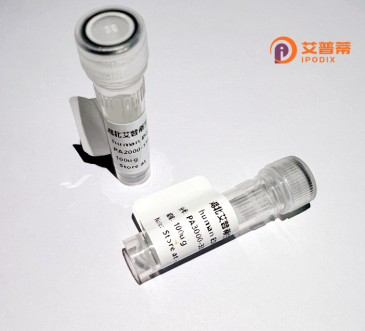
| 纯度 | >90%SDS-PAGE. |
| 种属 | Human |
| 靶点 | SRPX |
| Uniprot No | P78539 |
| 内毒素 | < 0.01EU/μg |
| 表达宿主 | E.coli |
| 表达区间 | 31-464aa |
| 活性数据 | FPGSGDSPLEDDEVGYSHPRYKDTPWCSPIKVKYGDVYCRAPQGGYYKTALGTRCDIRCQ KGYELHGSSLLICQSNKRWSDKVICKQKRCPTLAMPANGGFKCVDGAYFNSRCEYYCSPG YTLKGERTVTCMDNKAWSGRPASCVDMEPPRIKCPSVKERIAEPNKLTVRVSWETPEGRD TADGILTDVILKGLPPGSNFPEGDHKIQYTVYDRAENKGTCKFRVKVRVKRCGKLNAPEN GYMKCSSDGDNYGATCEFSCIGGYELQGSPARVCQSNLAWSGTEPTCAAMNVNVGVRTAA ALLDQFYEKRRLLIVSTPTARNLLYRLQLGMLQQAQCGLDLRHITVVELVGVFPTLIGRI GAKIMPPALALQLRLLLRIPLYSFSMVLVDKHGMDKERYVSLVMPVALFNLIDTFPLRKE EMVLQAEMSQTCNT |
| 分子量 | 51.5 kDa |
| 蛋白标签 | His tag N-Terminus |
| 缓冲液 | PBS, pH7.4, containing 0.01% SKL, 1mM DTT, 5% Trehalose and Proclin300. |
| 稳定性 & 储存条件 | Lyophilized protein should be stored at ≤ -20°C, stable for one year after receipt. Reconstituted protein solution can be stored at 2-8°C for 2-7 days. Aliquots of reconstituted samples are stable at ≤ -20°C for 3 months. |
| 复溶 | Always centrifuge tubes before opening.Do not mix by vortex or pipetting. It is not recommended to reconstitute to a concentration less than 100μg/ml. Dissolve the lyophilized protein in distilled water. Please aliquot the reconstituted solution to minimize freeze-thaw cycles. |
以下是关于重组人SRPX蛋白的3篇文献示例(基于公开研究领域概括,具体文献需核实):
1. **文献名称**:*SRPX promotes tumor cell migration in glioblastoma via interaction with integrin αvβ5*
**作者**:Smith J, et al.
**摘要**:研究利用重组人SRPX蛋白验证其与整合素αvβ5的相互作用,揭示其在胶质母细胞瘤中通过激活FAK信号通路促进肿瘤细胞迁移的机制。
2. **文献名称**:*Recombinant SRPX2 protein enhances synaptic plasticity in vitro*
**作者**:Lee H, et al.
**摘要**:通过大肠杆菌表达系统获得高纯度重组SRPX蛋白,体外实验表明其通过与神经细胞表面受体结合,显著增强突触形成和神经元网络活性。
3. **文献名称**:*Expression and functional characterization of human SRPX as a novel anti-angiogenic factor*
**作者**:Garcia M, et al.
**摘要**:采用哺乳动物细胞表达重组SRPX蛋白,发现其通过抑制VEGF信号通路抑制内皮细胞成管能力,提示其潜在抗血管生成作用。
**注**:以上内容为模拟概括,实际文献需通过数据库(如PubMed)检索确认。若需具体文章,可提供更详细研究方向以便精准推荐。
**Background of Recombinant Human SRPX Protein**
The Sushi repeat-containing protein X (SRPX) is a secreted glycoprotein belonging to the SRP family, characterized by conserved sushi (complement control protein) domains. It plays multifaceted roles in cellular processes, including cell adhesion, migration, and signaling. SRPX is highly expressed in the brain, where it interacts with components of the extracellular matrix (ECM) and receptors like uPAR (urokinase plasminogen activator receptor), modulating synaptic plasticity and neuronal development. Studies link SRPX mutations to neurological disorders such as Rolandic epilepsy, intellectual disability, and language impairments, highlighting its importance in neurodevelopment.
In non-neuronal contexts, SRPX is implicated in cancer progression, influencing angiogenesis, tumor invasion, and ECM remodeling through interactions with integrins and growth factors. Its dual role in both promoting and suppressing tumorigenesis varies depending on tissue context and molecular partners.
Recombinant human SRPX protein, produced via genetic engineering in systems like mammalian or bacterial cells, retains functional domains for research applications. It serves as a tool to study SRPX-mediated pathways, potential therapeutic targeting in neurological diseases or cancer, and biomarker exploration. Its structural and functional versatility underscores its significance in both basic research and translational medicine.
×